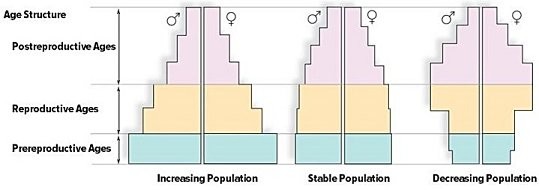From the perspective of population growth, what three major age groups does a population contain? Draw three age structure diagrams that roughly depict the proportion of these three age groups in an increasing population, a stable population, and a decreasing population.
What will be an ideal response?
The three age groups are those of prereproductive age, those of reproductive age, and those of postreproductive age. The diagrams of increasing, decreasing, and stable populations are shown.
You might also like to view...
Answer the following statements true (T) or false (F)
1. Tandem mass spectrometry can be used to determine the amino acid sequence of a peptide. 2. Bioremediation utilizes newly developed synthetic chemicals to decrease pollution in the environment. 3. A GMO is homozygous for a cloned gene. When it carries a mutation that inactivates the gene's function it is termed a gene knockout. 4. Chromosomes within somatic cells of mammals incur irreversible genetic changes, rendering them unsuitable for cloning.
Which is a risk that must be assumed when we genetically engineer a living individual? a. On which chromosome will the virus integrate the injected gene
b. The inserted gene may disrupt the normal genetics of the cell. c. All are risks associated with gene therapy. d. Development of an allergic reaction to the viral vector. e. Cancer may be the result of the inserted gene.
Human white blood cells are often multinucleated (in other words, have more than one nucleus). How many chromosomes would be present in a human white blood cell with two nuclei?
A. 46 B. 184 C. 92 D. It varies depending on gender.
Which layer of cells controls the movement of nutrient minerals entering the xylem in the root's interior?
a. endodermis b. Casparian strip c. epidermis d. cortex e. periderm